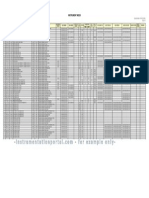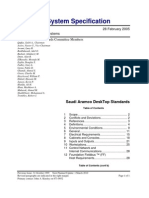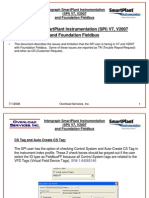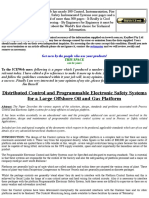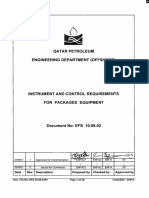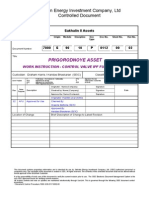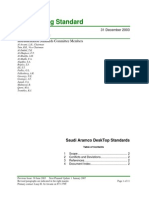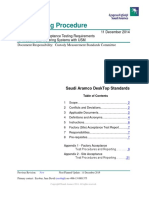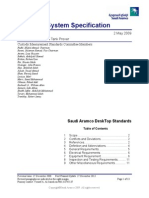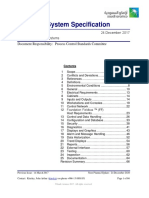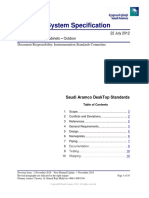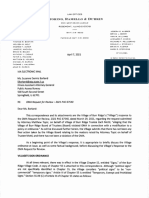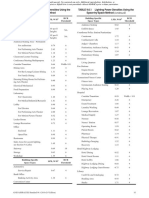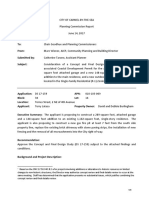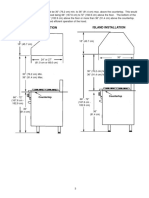34-SAMSS-820 - Instrument Control Cabinets - Indoor
34-SAMSS-820 - Instrument Control Cabinets - Indoor
Uploaded by
Mohamed RafihCopyright:
Available Formats
34-SAMSS-820 - Instrument Control Cabinets - Indoor
34-SAMSS-820 - Instrument Control Cabinets - Indoor
Uploaded by
Mohamed RafihCopyright
Available Formats
Share this document
Did you find this document useful?
Is this content inappropriate?
Copyright:
Available Formats
34-SAMSS-820 - Instrument Control Cabinets - Indoor
34-SAMSS-820 - Instrument Control Cabinets - Indoor
Uploaded by
Mohamed RafihCopyright:
Available Formats
Materials System Specification
34-SAMSS-820
Instrument Control Cabinets - Indoor
1 January 2013
Document Responsibility: Instrumentation Standards Committee
Saudi Aramco DeskTop Standards
Table of Contents
1
Scope............................................................. 2
Conflicts and Deviations................................. 2
References..................................................... 3
Definitions....................................................... 4
General Requirements................................... 4
Design............................................................ 5
Electrical......................................................... 9
Testing and Inspection................................. 22
Shipment.... 23
Previous Issue: 6 September 2011 Next Planned Update: 1 January 2017
Revised paragraphs are indicated in the right margin
Primary contact: Tarawn, Al Ahmed Roja Mahd on +966-3-8801344
CopyrightSaudi Aramco 2013. All rights reserved.
Page 1 of 23
Document Responsibility: Instrumentation Standards Committee
Issue Date: 1 January 2013
Next Planned Update: 1 January 2017
34-SAMSS-820
Instrument Control Cabinets - Indoor
Scope
This specification defines the requirements for instrument control panels, control
cabinets, and marshalling cabinets for location in electrically unclassified airconditioned buildings.
Programmable Logic Controller (PLC), auxiliary systems, and Rotating Equipment
Protection control cabinets must adhere to this specification.
Excluded from this specification are:
a)
Vendor standard Fire Detection / Suppression Panels / Cabinets used for building
protection.
b)
Vendor standard Security Alarm Panels / Cabinets.
c)
System Cabinets for Distributed Control System (DCS) except as referenced in
23-SAMSS-010.
d)
Consoles and server cabinets for Distributed Control Systems (DCS) except as
referenced in 23-SAMSS-010.
e)
Control panels that are provided as part of packaged Units.
f)
ESD System Cabinets except as referenced in 34-SAMSS-623.
g)
RTU System Cabinets except as referenced in 23-SAMSS-030.
Conflicts and Deviations
2.1
Any conflicts between this specification and their applicable Saudi Aramco
Materials System Specifications (SAMSS), Engineering Standards (SAESs),
Standard Drawings (SASDs), or industry standards, codes and forms shall be
resolved in writing by the Company or Buyer Representative through the
Manager, Process & Control Systems Department of Saudi Aramco, Dhahran.
2.2
Direct all requests to deviate from this specification in writing to the Company or
Buyer Representative, who shall follow internal company procedure SAEP-302
and forward such requests to the Manager, Process & Control Systems
Department of Saudi Aramco, Dhahran.
2.3
The designation Commentary is used to label a sub-paragraph that contains
comments that are explanatory or advisory. These comments are not mandatory,
except to the extent that they explain mandatory requirements contained in this
SAMSS.
Page 2 of 23
Document Responsibility: Instrumentation Standards Committee
Issue Date: 1 January 2013
Next Planned Update: 1 January 2017
34-SAMSS-820
Instrument Control Cabinets - Indoor
References
Referenced standards and specifications shall be the latest edition, revision or
addendum in effect on the date of the Purchase Order, unless stated otherwise.
3.1
Saudi Aramco References
Saudi Aramco Engineering Procedure
SAEP-302
Instructions for Obtaining a Waiver of a Mandatory
Saudi Aramco Engineering Requirement
Saudi Aramco Materials System Specifications
23-SAMSS-010
Distributed Control Systems
34-SAMSS-623
Programmable Controller Based ESD Systems
23-SAMSS-030
Remote Terminal Unit
Saudi Aramco Inspection Requirements
175-343100
3.2
Instrument Control Panels
Industry Codes and Standards
National Fire Protection Association
NFPA 70 (2011)
National Electrical Code
National Electrical Manufacturers Association
NEMA ICS 6
Enclosures for Industrial Controls and Systems
NEMA 250
Enclosures for Electrical Equipment (1000 Volts
Maximum)
International Electro-Technical Commission
IEC 61000-4-3
Radiated Electromagnetic Field Requirements
International Society for Measurement and Control
ISA RP60.6
Nameplates, Labels and Tags for Control Centers
Underwriters Laboratories, Inc.
UL 94
UL Standard for Safety Test for Flammability of Plastic
Materials for Parts in Devices and Appliances
Page 3 of 23
Document Responsibility: Instrumentation Standards Committee
Issue Date: 1 January 2013
Next Planned Update: 1 January 2017
34-SAMSS-820
Instrument Control Cabinets - Indoor
Definitions
Control Panel: A surface with cut-out(s) used to mount control devices and/or
instrument indicators (e.g., totalizers, pushbuttons, pullbuttons, indicating lights, meters,
annunciators, etc.).
Control Cabinet: An enclosed structure containing electronic equipment and wiring
for process control / status devices. (The front surface of a control cabinet may include
a control panel.). Cabinets containing DCS field termination assemblies (FTAs) should
be treated as control cabinets.
Marshalling Cabinet: A cabinet containing mainly terminal strips and wire
terminations. The field wiring is normally terminated in the Marshalling Cabinet.
Cabinets: Generically used within this specification; refers to all of the above.
General Requirements
5.1
Engineering Units
All dimensions and measurements shall be in the International System of Units
(SI), and may be followed by the equivalent value in English units between
brackets. When not critical, the equivalent dimensions may be rounded off to
their nearest practical value.
Exception:
This requirement does not apply to the vendor's standard documentation.
5.2
Environmental Conditions
All cabinet equipment and wiring shall be designed for continuous operation at
50C, and relative humidity 80% maximum (non-condensing) and 20% minimum.
Commentary Note:
The temperature of 50C allows for a 35C room ambient plus a 15C rise within
the cabinet.
5.3
Heat dissipation calculations shall be submitted for any cabinet that houses
power supplies, PCs or other heat generating components. The calculations
shall show that the components installed inside the cabinet will not be exposed
to a temperature above their temperature rating.
Page 4 of 23
Document Responsibility: Instrumentation Standards Committee
Issue Date: 1 January 2013
Next Planned Update: 1 January 2017
34-SAMSS-820
Instrument Control Cabinets - Indoor
Design
6.1
Style
The cabinets shall be rigid and self-supporting. Unless otherwise specified, the
cabinets shall be free standing, floor mounted type. Instruments and electronic
accessories shall be wired in accordance with this specification. Indoor cabinets
shall be made of metal. When multiple cabinets are provided, it is highly
recommended that they are identical in construction and external appearance.
6.2
Drawings
6.2.1
The cabinet fabricator shall supply detailed drawings for review and
approval.
6.2.2
The detailed drawings, shall as a minimum, contain the following
information:
a)
Cabinet fabrication drawings showing dimensions for exterior,
openings, removable plates, doors and door swings, internal
cabinet segregation, internal frame supports/bracing, ventilation
louvers, lifting bolts, and shipping breaks.
b)
Cabinet layout drawings showing the locations and arrangements
of all electronic equipment, terminal strips, fuses, plastic ducts,
raceways, pushbuttons, switches, lamps, name plates,
annunciators, rack-mounted equipment, power supplies,
convenience outlets, lighting and grounding strips. Electronic
equipment manufacturer and model numbers shall be shown.
c)
Wiring diagrams showing termination strips and all electronic
interconnections, with tag names and equipment/terminal
identification.
Items a) and b) shall be drawn to scale and supplied as vendor
drawings for the proponents review and approval. Item c) shall be
issued with proponent drawing numbers and completed in the
Intergraph or convertible format.
6.2.3
All instruction manuals and technical information supplied with
components received by the Cabinet Fabricator shall be placed in a
folder or binder and shipped with the cabinet.
6.2.4
All Vendor literature and drawings shall be of sufficient size and
quality to be clearly legible.
Page 5 of 23
Document Responsibility: Instrumentation Standards Committee
Issue Date: 1 January 2013
Next Planned Update: 1 January 2017
6.3
34-SAMSS-820
Instrument Control Cabinets - Indoor
Construction
6.3.1
The cabinet shall be a NEMA Type 1 as a minimum per NEMA 250 and
NEMA ICS 6 or as specified in the functional specification document.
6.3.2
Cabinets requiring heat dissipation shall be convection-ventilated.
6.3.3
Convection-ventilated cabinets shall be provided with readily accessible,
removable filter screens inserted behind slotted louvers at the air inlets
and outlets. Louvers and filters shall be installed within the cabinet
door(s). Louvers shall not be installed on the sides or back of the cabinet.
6.3.4
Fans with suitable filters and louvers may be used within Cabinets to
assist in heat removal. This can be achieved by installing a filter fan at
the air inlet (typically at the bottom of the cabinet door) to blow cool
air into the cabinet or by installing an exhaust filter fan at the air outlet
(typically at the upper section of the door) to draw hot air out of the
cabinet. The fan filter shall be easily accessible for maintenance or
replacement without dismantling the fan assembly.
6.3.5
If the fans are required to dissipate heat when the HVAC is running,
redundant fans shall be provided. If the fan(s) are only required to
dissipate heat when the HVAC is not running, a single fan is adequate.
In both cases, fan failure or over-temperature detection and alarm are
required in the DCS.
6.3.6
The installation of fans on top of the cabinet should be avoided.
However, if it is deemed absolutely necessary to install the fans on top
of the cabinet, the fan fixtures shall be protected by an additional cover
or shroud to prevent dirt and debris from falling into the cabinet.
6.3.7
Where two or more front sections are required for a Control Panel, the
interior shall be an open-frame construction.
6.3.8
Cabinet support bracing shall not restrict maintenance access to
chassis, modules or components. The cabinet shall be properly sized to
have easy access to all installed components and wires. Accessing any
of the installed components or wiring shall not require the removal of
other components.
6.3.9
Each cabinet shall be provided with removable lifting rings.
6.3.10
Cabinet doors shall be full-height. All doors shall be dust-tight and
reinforced against buckling. The maximum door width shall be
900 mm (36 inches) unless otherwise specified in the Purchase Order.
Page 6 of 23
Document Responsibility: Instrumentation Standards Committee
Issue Date: 1 January 2013
Next Planned Update: 1 January 2017
34-SAMSS-820
Instrument Control Cabinets - Indoor
6.3.11
The marshalling cabinets, from the front surface to the surface of rear
terminal blocks, shall not be more than 46 cm (18 inches) deep to
provide for safe access. The preferred design is to divide a 76 cm
(30 inch) deep cabinet into 38 cm (15 inch) sections with front and rear
access.
6.3.12
All doors shall be capable of opening at least 90 degrees, preferably
180 degrees, and shall be equipped with mechanical stops for holding
the doors open.
6.3.13
When front and rear access is provided, the central separation plate(s)
shall be full height. In addition, each section of the cabinet shall be
treated as a stand-alone cabinet that fully meets the requirement of this
material specification document.
6.3.14
Where practically possible, control cabinets and panels should only
have a single door access. Marshalling cabinets may have two door
access on each side (front and rear).
Exception:
With the approval of the proponent, control cabinets housing subsystems (such as such as VMS, PLC, turbo machinery control, etc.)
may have dual doors on both sides provided that the front and back
sections are treated per Paragraph 6.3.13 above. Typically, one side
would be used for marshalling and the other side for system chasses.
6.4
6.3.15
All doors shall be provided with integral lockable door handles with the
same lock and key combination, unless otherwise specified on the ISS.
6.3.16
Equipment that are installed within cabinets or panels and are normally
used by the operator shall be readable and operable with the operator in
a standing position.
6.3.17
The inside of each door shall be equipped with a pocket suitable for
holding A4 documents and/or cabinet drawings.
6.3.18
Cabinets intended for bottom cable entry shall be provided with a
gland plate at the bottom of the cabinet.
Cabinet Finish
6.4.1
The exterior and interior cabinet finish shall be the Cabinet Fabricator's
standard finish, unless otherwise specified in the Purchase Order.
A minimum of primer, undercoat and finishing coat of enamel or
lacquer is required. Electrostatic applied powder paint coatings which
are then baked (such as polyester urethane) is acceptable.
Page 7 of 23
Document Responsibility: Instrumentation Standards Committee
Issue Date: 1 January 2013
Next Planned Update: 1 January 2017
6.4.2
6.5
6.6
34-SAMSS-820
Instrument Control Cabinets - Indoor
Interior cabinet color shall be white or of a light color such as light gray,
off-white, etc., or as specified in the purchase order.
Nameplates
6.5.1
Nameplates for cabinets and panels letter height and spacing shall
follow ISA RP60.6, Appendices A and C, unless otherwise specified in
the purchase order.
6.5.2
Where possible, nameplate abbreviations shall be avoided.
Where abbreviations are used, they shall be consistent with facility
practices. ISA RP60.6 (Appendix B) shall be used to keep
abbreviations consistent where facility practice is not established.
6.5.3
Control panel pushbuttons, switches, indicating lights and other
through-mounted devices shall be identified with the service
description on the front. The rear of the above devices shall be
identified with the device tag number. The nameplates shall be
permanently attached. Adhesives are allowed for indoor panels.
6.5.4
Instruments and accessories mounted inside the cabinet shall be
identified with a nameplate showing the tag number. Individual rack
modules are not required to have permanent nameplates attached.
6.5.5
Nameplates shall be made from laminated plastic, white-black-white
(information engraved into the black core) with white surface, dull finish.
6.5.6
Each cabinet, front and rear, shall be identified with a nameplate located
above each door or pair of doors. The nameplate, as a minimum, shall
be the cabinet name/number as given in the cabinet drawings.
Cabinet and Panel Spare Requirements
6.6.1
Unless otherwise specified in the Purchase Order, each cabinet shall be
provided with the following spare capacity to allow for future system
modifications:
a)
20% installed spare terminal blocks of each terminal block type
used. Spare terminal blocks are to be distributed to match the
layout of required spare I/O modules, field termination
assemblies, relays, etc.
Commentary Note:
The 20% spare terminal requirement is intended to be used for
the 20% spare cabling required in homerun cables. It is not
Page 8 of 23
Document Responsibility: Instrumentation Standards Committee
Issue Date: 1 January 2013
Next Planned Update: 1 January 2017
34-SAMSS-820
Instrument Control Cabinets - Indoor
intended to be additional terminals on top of terminals used to
terminate spare pairs/triads.
b)
10% spare relay bases in cabinets where there are ten relays or
more. For less than ten relay installations, one spare base should
be installed.
Exception:
The above requirement does not apply on cabinets where only
one relay is installed for fan failure or alarm.
6.6.2
The Cabinet Fabricator shall supply a minimum of two (2) spare fuses
or 10% (whichever is greater) for each type of general power and
termination strip fuses used within each cabinet. This requirement
includes supplying spares for fuses integral to installed electronics
(i.e., flow computers, field termination assemblies, etc.).
Electrical
7.1
Power Supply
7.1.1
Power Supplies feeding process instruments shall be powered from
instrument circuit power distribution panels. Each distribution strip
shall be dedicated to a single voltage level. Instrumentation circuit
breakers and distribution strips shall not provide power to noninstrumentation circuits. The cabinet shall be furnished with a
minimum of 20% spare circuit breakers.
Exception:
If the cabinet is equipped with only one circuit breaker for cabinet
lighting, spare breakers are not required.
7.1.2
Power wiring for field instruments, all input and output points, twowire analog transmission loops, field switch contacts, etc., shall be
individually fused and provided with a means of disconnecting the
power without disturbing terminated wiring (e.g., knife-switch-type
terminal blocks). Daisy chaining of external loop power using wires or
wire crimps is not acceptable.
Exceptions:
1)
Wiring connected to I/O modules or interfaces containing individual
current-limiting circuit protection does not require fuses.
2)
Low Voltage wiring connected directly to I/O. (See paragraph 7.6)
Page 9 of 23
Document Responsibility: Instrumentation Standards Committee
Issue Date: 1 January 2013
Next Planned Update: 1 January 2017
34-SAMSS-820
Instrument Control Cabinets - Indoor
Commentary Note:
Fuse application, location, and ampacity ratings must be properly sized
and coordinated, taking into account the maximum expected load at the
maximum operating temperature of the cabinet (50C).
7.1.3
Unless otherwise specified, equipment shall operate at the supply
voltages shown in Table 1.
Table 1 Supply Voltage
System/Device
Nominal
Tolerance
NEC Class
Annunciator Power
Shutdown and Isolation
System including relay coils
Field Switch Contacts
24 VDC
21 - 28.2 VDC
1 or 2
125 VDC
120 VAC, 60 2 Hz
113 - 141 VDC
110 - 126 VAC
1 or 3
1 or 3
Analog Signal (Loop Power)
24 VDC (4-20 mA)
24 VDC
120 VAC, 60 2 Hz
21 - 28.2 VDC
21 - 28.2 VDC
110 - 126 VAC
1 or 2
1 or 2
1 or 3
Instrumentation Power
Note:
The basis for the upper DC voltage variations is due to installations where battery backup is used without voltage suppression and the batteries receive periodic charging.
7.1.4
Where multiple on-line DC power supplies are connected to a single
power bus, diode auctioning shall be used to facilitate load balancing in
the event of a single power supply failure. Where multiple DC power
supplies are an integral part of a manufacturer's standard product, the
manufacturer's standard method of load sharing shall apply.
7.1.5
Supplies to DC instrument loads: Voltage stabilization shall be provided
to maintain the output voltage within tolerable limits of the loads served.
7.1.6
Power supplies shall be identical whenever possible for
interchangeability and spare part requirements.
7.1.7
Power supply outputs shall be individually fused or protected by
dedicated circuit breakers.
7.1.8
Power Supply terminal block distribution wiring shall not be daisychained using wires or crimp connectors. Jumper bars or preformed
jumper combs designed for the specific terminal blocks being used are
acceptable methods of distributing power supply wiring.
7.1.9
Power supply load calculations shall be provided by the vendor
showing a minimum 10% spare power capacity on the running power
supply and its redundancy.
Page 10 of 23
Document Responsibility: Instrumentation Standards Committee
Issue Date: 1 January 2013
Next Planned Update: 1 January 2017
7.1.10
7.2
34-SAMSS-820
Instrument Control Cabinets - Indoor
The cabinet shall be equipped with a common power supply
fault/failure alarm switch. The switch should be connected to the DCS
or panel front for alarming.
Wire Installation
7.2.1
Splices are not permitted in wiring. When wiring must be extended,
connections shall be made via terminal blocks.
7.2.2
Twist-on wire nut connectors shall not be used for making any
electrical instrumentation terminations.
7.2.3
Segregation of parallel wiring internal to cabinets shall adhere to the
following Table 2. All dimensions are shown in millimeters.
Table 2
0
0
0
0
25
25
150
75
150
75
4-20 mA
Analog
24 VDC
0
0
0
0
0
0
75
25
75
25
24 VDC
Power/
Digital
25
25
0
0
0
0
25
0
75
0
0
0
0
0
0
0
Signal
Category
Milli Volt
T/C RTD
Milli Volt
T/C RTD
4-20 mA
24 VDC
125 VDC
120 VAC
Copper
Network
Cable
125 VDC
120 VAC
150
75
75
25
25
0
0
0
0
0
150
75
75
25
75
0
0
0
0
0
Copper
Network
Cable
0
0
0
0
0
0
50
25
75
50
50
25
75
50
0
0
Notes:
1)
Upper Value Spacing is for wires in plastic ducts.
2)
Lower Value Spacing is for wires separated by:
a)
One metal conduit or
b)
A 1/16-in. thick grounded steel divider.
3)
Voltages shown are nominal.
7.2.3.1
Separate plastic ducts are preferable for all Signal Categories
that require separation for organization and noise reduction.
Signal Categories with upper values of zero separation may
be mixed in a plastic duct. Signal Categories shall not be
mixed within any single multicore cable.
Page 11 of 23
Document Responsibility: Instrumentation Standards Committee
Issue Date: 1 January 2013
Next Planned Update: 1 January 2017
34-SAMSS-820
Instrument Control Cabinets - Indoor
Example:
24 VDC digital and 24 VDC 4-20 mA may be run in the same
plastic duct, but not within a single multipair cable.
7.2.3.2
7.3
7.4
Wiring that is required to be segregated shall cross at right
angles and the spacing shall be maintained as close as
practicable to that shown in Table 2.
Wire Specifications
7.3.1
General 120 VAC power wiring shall be minimum 14 AWG stranded
copper, UL listed and PVCor XLPE insulated. Wire insulation shall be
rated for 600 volts, 75C, minimum.
7.3.2
Electronic signal wire shall be UL listed, stranded copper, minimum
size 18 AWG, 300 V for single conductors or a minimum 20 AWG,
300 V for multicore cable (assuming Class-2 circuits per NEC).
Wire insulation shall be XLPE PVC, or PTFE, with a minimum
temperature rating of 75C. Special electronic signal wires shall be as
described in the Purchase Order.
Wiring Methods
7.4.1
Cabinets containing electronic equipment with field inputs/outputs
(I/O) (e.g., field termination assemblies, I/O modules, etc.) shall have
the I/O device pre-wired to:
1)
intermediate terminal strips within the same cabinet shipping
section, or;
2)
to intermediate terminals within the same building by the use of
manufactured multi-conductor cable and plug connectors.
Commentary Note:
Field wiring shall be terminated on the intermediate terminal
strips (by others). This process makes it easier to land field wires
on-site and minimizes possible damage to vendor equipment
during termination of field wires.
Exception:
See 7.6 for low voltage wiring exceptions to the use of
intermediate terminal strips.
7.4.2
Exposed electrical connections with voltages greater than nominal
48 volts AC/DC shall be shrouded by transparent, removable,
insulating plastic covers (or equivalent).
Page 12 of 23
Document Responsibility: Instrumentation Standards Committee
Issue Date: 1 January 2013
Next Planned Update: 1 January 2017
7.4.3
34-SAMSS-820
Instrument Control Cabinets - Indoor
When screw-type terminals are provided on instruments and other
electrical devices, solderless crimp/compression connectors shall be
used for connecting stranded copper conductors. Insulated ring lugs,
locking-fork or flanged- fork connectors, specifically designed to hold
the connector on the terminal in the event of loosening of the terminal
screw, shall be used on all such connections.
Commentary Note:
Screw-type terminals are defined as those in which the termination
method involves the direct compression of the conductor by the
underside of the screw head, and which do not contain the conductor
within a clamp or yoke.
7.4.4
7.5
7.6
When a cabinet contains CPU and I/O modules, the racks shall be
arranged so that the processor modules are installed in the top and the
I/Os are installed next to the processor modules or beneath them.
Annunciator Wiring
7.5.1
When specified, annunciator shall have a horn relay wired to terminals
for connection to the remote horn system.
7.5.2
Annunciator(s) shall have a lamp/horn test, acknowledge and reset
button unless otherwise specified in the Purchase Order.
Wiring for Millivolt, Microamp, Pulse and Frequency Signals
Wiring for millivolt, microamp, pulse and frequency signals under 1 Volt such as
thermocouples, resistance temperature detectors (RTD), vibration elements,
analyzer elements, thermistor elements and transmitters with pulse outputs may be
directly connected to the I/O unless otherwise specified in the Purchase Order.
7.7
Terminal Strips
7.7.1
The termination method shall be channel (rail)-mounted terminal blocks.
7.7.2
Terminal strip spacing shall allow ample room for plastic wire ducts
and permit lacing of cables, and fanning of individual wires to
termination points. Each terminal strip shall be labeled above or below
with the terminal strip number, as shown on wiring diagrams.
Terminals for similar (AC or DC) current service shall be grouped
together and physically separated from terminals for different service
by means of dividers, separate mounting rails or separate enclosures.
7.7.3
Standoffs for terminal strips are preferred to bring the terminal blocks
forward to be flush with the top of the plastic wire duct. This wiring
Page 13 of 23
Document Responsibility: Instrumentation Standards Committee
Issue Date: 1 January 2013
Next Planned Update: 1 January 2017
34-SAMSS-820
Instrument Control Cabinets - Indoor
method assures that all wires can be accessed without interference
from other wires as the wire duct is filled.
7.8
7.7.4
Where special cases of mixed ESD / Non-ESD signals occur in one
cabinet or control panel (e.g., Solid State / Relay Control Cabinets or
Control Panels with ESD pushbuttons ), terminal strips for Emergency
Shutdown (ESD) wiring shall be completely separate from all other
wiring including power, control and instrumentation.
7.7.5
Wiring for a given instrument loop shall be terminated on adjacent
terminals on the terminal strip in order to organize and group all loop
wiring.
7.7.6
Terminals for various types of general wiring (AC or DC), annunciator
points and signal wiring shall be separately grouped and separated by
dividers.
Terminal Blocks
7.8.1
No more than two bare wires shall be connected to each side of a
single terminal block.
7.8.2
All terminal blocks shall be channel (rail)-mounted, strip-type, with a
tubular box clamp connector and compression bar or yoke for wire
termination. As a minimum, the thickness of the terminals shall be
5 mm or higher. All terminals shall be numbered on both sides.
7.8.3
Terminals shall be made of fire retardant, halogen free, high strength
material such as polyamide or equivalent in accordance with UL 94,
V0. Brittle materials such as melamine shall not be used.
7.8.4
A fused terminal block shall have a blown-fuse indicator. This may be
a Light Emitting Diode (LED), visual sight indication through a port,
or equivalent.
7.8.5
The disconnect levers for fused terminals and knife-switch terminals
shall be hinged.
7.8.6
Wires terminated on these terminal blocks shall not have the bare ends
coated with or dipped in solder (tinned). However, termination of
wiring which has individual strands of the copper conductor tinned
during manufacture (typical of shield drain wires or for corrosion
protection) is acceptable.
7.8.7
Direct termination of the bare wire end is acceptable. The terminal
block must be suited for the wire size. The use of crimp-on ferrules
Page 14 of 23
Document Responsibility: Instrumentation Standards Committee
Issue Date: 1 January 2013
Next Planned Update: 1 January 2017
34-SAMSS-820
Instrument Control Cabinets - Indoor
shall follow the manufacturer's guidelines and the following:
a)
One or two wire ferrule is acceptable. However, the use of
ferrules to daisy chain is not acceptable.
b)
Only one ferrule shall be connected to each side of a single
terminal block.
c)
Ferrules shall be provided with plastic insulating collars.
7.8.8
Terminal blocks with a narrow, recessed screw entrance which require
a special screwdriver or wrench may be used only if the insulation
material is per Paragraph 7.8.3.
7.8.9
Multiple-deck and spring type terminal blocks shall not be used.
Exception:
When provided as an integral part of manufactured electronic
equipment, multiple-deck terminal blocks are allowed, but never for
direct termination of field cabling.
7.9
Wire Ducts and Looms
7.9.1
Plastic wire ducts with removable covers shall be installed in cabinets
as required to provide a means of routing and organizing wiring.
A minimum of 50 mm shall be maintained between the duct and
terminal strips. Wire markers shall be completely presented without
being obscured by the duct.
7.9.2
The maximum conduit/plastic wire duct fill (including spare capacity)
shall not exceed the heat requirements of NFPA 70 Section 300.17.
7.9.3
In addition to the above, the maximum plastic wire duct fill (including
spare capacity) shall not exceed 75% of its depth.
7.9.4
Plastic wire ducts shall be mounted using screws. Double-sided tape is
unacceptable.
7.9.5
Where space limitations preclude the use of plastic wire ducts, wiring
shall be neatly loomed and secured with plastic spiral wrapping or tiewraps and anchors. Wiring between movable parts such as doors shall
be installed in flexible hoses.
7.9.6
Loomed wiring shall not be installed near sharp-edged surfaces.
7.9.7
Wiring shall not be threaded through undressed access holes. Glands
or protective grommets shall be used.
Page 15 of 23
Document Responsibility: Instrumentation Standards Committee
Issue Date: 1 January 2013
Next Planned Update: 1 January 2017
7.10
34-SAMSS-820
Instrument Control Cabinets - Indoor
7.9.8
Vendor-installed cables shall be supported and provided with a strainrelief mechanism for cable connectors.
7.9.9
Wire ducts for ESD wiring shall not contain any other types of wiring.
Wire Color Coding
AC Power Supply:
DC Power Supply:
Hot
Neutral
Ground
Negative
Positive
Black
White or gray
Green or green with yellow tracer
Black
Red
If the wire insulation cannot be color-coded as above, the wire must be sleeved
with the required color. The sleeve shall cover from the cut insulation end to a
point past where the conductor enters the plastic wire duct or a minimum of
4 inches, whichever is less. Sleeves shall not be used over green insulation.
Blue color shall not be used except in intrinsically safe circuits.
7.11
Wire Tagging
7.11.1
Cables with connector plugs shall be tagged at each end. Each cable tag
shall have two labels. The first label (closest to the plug connector) shall
identify the device and socket to which the plug is to be connected.
The second label shall identify the device and socket to which the
opposite end of the cable is connected. The two tags may be combined
into one tag with sufficient separation between the two labels.
7.11.2
The interconnecting wiring shall be tagged at each end with two
identification tags (or the two may be combined into one tag with
sufficient separation between wire numbers). The first tag (closest to
the end of the wire) shall identify the terminal number to which the
wire is physically connected. The second tag shall identify the
terminal number to which the opposite end of the wire is connected.
Commentary Notes:
Where jumpers are installed between terminal blocks in the same row or
column and are clearly visible, wire tagging is not necessary.
Identification shall be in accordance with designations shown on
instrument loop diagrams (ILDs). Where wires terminate on instrument
or device terminals, the instrument tag number and terminal designation
(+) or (-) (if applicable) will be used in lieu of terminal strip identification.
Page 16 of 23
Document Responsibility: Instrumentation Standards Committee
Issue Date: 1 January 2013
Next Planned Update: 1 January 2017
34-SAMSS-820
Instrument Control Cabinets - Indoor
Exceptions:
7.11.3
1)
Alternate wire tagging schemes, which conform to established local
practice, may be used for extensions to existing facilities with the prior
approval of the proponent.
2)
Vendor Standard wire tagging of interconnecting wiring is allowable
provided approval is granted by the proponent.
Wire tag information shall be permanently marked in block
alphanumerics or typed on tubular; heat shrinkable, slip-on sleeves.
Wrap-around, snap-on or self-adhesive markers shall not be used.
Where shrink fit cable markers cannot be installed over pre-made cable
and connectors, a suitable tie-wrap or equivalent type permanent
marker shall be used.
Exceptions:
1)
Alternate wire tagging schemes, which conform to established local
practice, may be used for extensions to existing facilities with the prior
approval of the proponent.
2)
Plastic sleeves that are specifically designed to fit on a specific wire
gauge and come with pre-printed alpha/numeric inserts (such as
Grafoplast Trasp System) may be used for wire tags with prior approval
of the proponent.
7.11.4
Wire and cable tags shall not be handwritten.
7.11.5
Wire tags shall be installed and oriented such that the tags are easily
read. (Upside down or covering of tag information by plastic duct
covers is not acceptable).
7.11.6
Spare pairs/triads in multi-pair/triad cables shall be labeled SPARE
in addition to the destination and source terminal numbers. All spares
are to be terminated.
7.11.7
Per NEC 310-120, all conductors and cables shall be marked to
indicate the following information:
7.11.8
1)
Maximum rated voltage for which the conductor was listed,
2)
The letter designators for type of wire or cable,
3)
Manufacture's name or trade mark,
4)
The AWG size or circular mil area.
All cable ties used inside of cabinets shall be weather resistant nylon
cable ties with a stainless steel barb. The cable tie shall have a
Page 17 of 23
Document Responsibility: Instrumentation Standards Committee
Issue Date: 1 January 2013
Next Planned Update: 1 January 2017
34-SAMSS-820
Instrument Control Cabinets - Indoor
maximum continuous use temperature rating of 85C or higher,
e.g., Panduit Dome-Top Barb Ty Cable Ties - Weather Resistant, or
equivalent.
7.12
7.13
Terminal Coding
7.12.1
Each row of terminals shall be clearly identified with an alphanumeric
label. Each row of ESD terminals shall additionally be marked to
show ESD service.
7.12.2
In addition to 7.12.1, each row of Power supply and bus terminals shall
be marked with voltage type and level. (e.g., +24 VDC, or 120 VAC,
etc.)
7.12.3
Numerical terminal identification and coding shall be assigned
sequentially (in ascending order, from top to bottom or left to right).
Each vertical row and group of rows shall be labeled separately.
Relays
7.13.1
Relays shall be of the electromechanical, dust-tight, 11-pin (3PDT) or
8-pin (DPDT) plug-in type.
Exceptions:
1.
Relays provided as an integral part of manufactured electronic
equipment installed within cabinets may use that manufacturer's
standard offering.
2.
For hermetically sealed relays, 4PDT, 14-pin relays may be used
provided that no more than two contacts are used.
7.13.2
Each relay shall be supplied with a bracket or holding clips to prevent
it from falling off the base (socket). Using relays that are permanently
attached to the relay base is not acceptable.
7.13.3
A dedicated relay base shall be provided for each relay. Using multisocket modules that can accommodate more than one relay is not
acceptable.
7.13.4
The mounting socket shall be provided with a plastic label, color
black-white (relay number engraved into the black core with white
surface, dull finish). The relay tag shall not be mounted directly on the
relay and shall be visible when the relay is installed. The relay number
shall be shown as presented in the detailed cabinet drawings.
7.13.5
DIN rail mounted relay bases are preferred.
Page 18 of 23
Document Responsibility: Instrumentation Standards Committee
Issue Date: 1 January 2013
Next Planned Update: 1 January 2017
7.14
34-SAMSS-820
Instrument Control Cabinets - Indoor
7.13.6
Coil voltage shall be as specified in the Purchase Order. Pull-in voltage
shall be 80% or less of nominal voltage.
7.13.7
All relays shall be provided with suppression diodes.
7.13.8
Relay configuration and pertinent operating information shall be
imprinted on the case.
Push Buttons and Lights
Push buttons and lights shall be industrial quality. Push buttons shall have
protective mechanisms to prevent accidental activation as required by the
detailed design specification. Long-life type lamps or LED cluster lamps shall
be used. It shall be possible to access the lamp bulbs from the front for
replacement. The color of the pushbuttons or lights shall be green for
ON/OPEN and red for OFF/CLOSE positions. Only screw terminals
shall be provided on push buttons.
Exception:
Existing facilities that currently deviate from the above light color specification
may use other conventions in order to keep the lighting philosophy consistent
within the facility.
7.15
Lamp Test Facilities
For all control panels with indicating lights, a lamp test button shall be provided
per panel.
Exceptions:
LED or other lamps integral to a manufacturer's electronic instrumentation do not
require the lamp test button.
Power status-indicating lights that are normally on where it is not desirable to
cross-feed lamp test power from an alternative source (Such as UPS power
status).
7.16
Circuit Breakers and Fuses
7.16.1
Individual circuit breakers shall be provided for each power supply
unit.
7.16.2
Fuses and circuit breakers shall be readily accessible for maintenance
with sufficient clearance from obstructions.
7.16.3
Tandem type (dual) circuit breakers in a single molded case shall not
be used, as the failure of one breaker requires complete replacement of
Page 19 of 23
Document Responsibility: Instrumentation Standards Committee
Issue Date: 1 January 2013
Next Planned Update: 1 January 2017
34-SAMSS-820
Instrument Control Cabinets - Indoor
the assembly.
7.16.4
7.17
7.18
Circuit breakers shall be installed in a manner that allows replacement
of a breaker without disruption to adjacent breakers. Circuit breakers
shall not be interconnected using wire jumpers, comb jumpers or
bridges of any type.
Marshalling Cabinet Shielding
7.17.1
Cable shields must have a single, continuous path to ground. Ground
loops and floating shields shall be avoided. Shields shall be
consolidated and ultimately connected to the Instrument Circuit
Ground Bar as detailed in paragraph 7.18.6.
7.17.2
Shield drain wires shall not be daisy-chained using bare wires or crimp
connectors to the ground connection.
7.17.3
Cable shields must have a continuous path to ground. Acceptable
methods of consolidating shields are as follows:
a)
Special grounding terminals in intimate contact with an electrically
isolated DIN Rail.
b)
Terminal Block jumper bars designed for the selected terminal
blocks.
c)
Preformed jumper combs designed for the selected terminal blocks.
d)
Electrically isolated bus bars running parallel to terminal blocks.
Grounding
7.18.1
Both safety ground and instrumentation circuit ground must conform to
NEC, Article 250. Grounding system recommendations and
requirements provided by manufacturers of instrumentation and control
systems (e.g., Distributed Control Systems) shall be followed.
7.18.2
Separate, electrically isolated grounding bars shall be provided, as
required.
7.18.3
All ground buses shall be made of a solid copper measuring the
following nominal dimensions 5mm x 40 mm x (y length), suitably
drilled and tapped for screw terminals and wire lugs, or fitted with
screw-type compression lugs.
Commentary Note:
The ground bus dimensions in Paragraph 7.18.3 are nominal.
Page 20 of 23
Document Responsibility: Instrumentation Standards Committee
Issue Date: 1 January 2013
Next Planned Update: 1 January 2017
34-SAMSS-820
Instrument Control Cabinets - Indoor
Buses that are slightly different in sizes are acceptable provided that
they are sized for the worst case ground currents.
7.18.4
The preferred location of the ground bus bars is at the bottom of the
cabinet.
7.18.5
A No. 2 AWG screw-type compression lug shall be provided on both
end of each ground bar for interconnection with the Master Instrument
Ground or Master Safety Ground.
7.18.6
The ground bus bars shall be labeled and wired as follows:
AC SAFETY GROUND for all exposed metal surfaces of cabinets,
racks, chassis GND connections, etc. Individual wiring interconnections
between the internal components and the bus shall be minimum
12 AWG copper wire, green with yellow tracer insulation. This bus
shall be directly bolted to the cabinet without the use of insulators.
INSTRUMENT CIRCUIT GROUND for connecting cable and wire
shields and DC Common. Interconnections between shield
consolidation points and the bus bar shall be minimum 12 AWG
copper wire, with green insulation. This bus bar shall be electrically
insulated from the cabinet structure.
7.18.7 When provided, AC power receptacle outlets shall be grounded using
ground wire terminated on the receptacle grounding terminal. (e.g., A
receptacle utilizing the faceplate as a ground path is not permitted.)
7.18.8
7.19
All enclosure doors and subpanels shall be electrically bonded to main
enclosure frame by a braided ground strap (wire size #8 AWG or
equivalent).
Lighting, Convenience and Power Distribution Receptacle Outlets
7.19.1
Cabinet lights shall be installed where practical and necessary, as
specified in the Purchase Order.
7.19.2
If specified, cabinet lights shall be 120 Volt, 60-watt incandescent
lamps, size IEC, type E27 or ES (Edison Medium Screw Base) fitting
or 15-watt minimum industrial grade, fluorescent lighting fixture(s)
oriented in such a manner that the majority of the interior portions of
the cabinet are illuminated.
7.19.3
Incandescent lamps shall have a guard to help protect the lamp from
accidental breakage. Fluorescent lamps shall have clear plastic sleeve
guards to help contain broken glass in case of an accident.
Page 21 of 23
Document Responsibility: Instrumentation Standards Committee
Issue Date: 1 January 2013
Next Planned Update: 1 January 2017
34-SAMSS-820
Instrument Control Cabinets - Indoor
7.19.4
When specified in the Purchase Order, convenience outlets shall be
duplex-type and rated at 120 VAC, 10 amp as a minimum.
7.19.5
Interior lamps and convenience outlets shall be wired to separate
thermal/magnetic circuit breakers which shall be powered from a
proponent-furnished AC distribution panel, independent of the UPS
power supply.
7.19.6
A switch in the cabinet (in addition to the circuit breaker) shall control
each lamp where the lamp is installed. Automatic door switches for
lamps are allowed.
Testing and Inspection
The items manufactured to this specification are subject to verification by the
proponents Inspection representative, per the proponents Inspection Requirements
Form attached to the Purchase Order.
The Cabinet Fabricator shall verify the operation of all instrumentation and controls.
Documented test procedures shall be submitted to the proponent for approval not less
than thirty (30) days before commencement of test. Tests shall include, but shall not be
limited to:
a)
A function test of all electronic instruments and electric control circuits and relays.
b)
Visual inspection to verify compliance with requirements of this specification.
c)
Complete wiring check with verification that terminal and wiring code conforms
to cabinet design drawings.
d)
A certificate of compliance to the RFI requirements of IEC 61000-4-3, Level 3.
The certificate(s) shall be for either the entire cabinet or for all the electronic
equipment installed within the cabinet.
EMI/RFI Interference (Radiated Susceptibility)
The cabinet electronic equipment shall perform within the normal limits without loss of
function or degradation of performance when subjected to radiated electromagnetic
fields in accordance with IEC 61000-4-3, Level 3, (at a 10 V/m power level), with
cabinet doors open. If certificates are not available, the equipment in the cabinet shall
function within the normal limit when tested with a 5 watt radio transceivers operating
at 5 Watts within the frequency ranges, 50-174 MHz, 406- 470MHz, and 800-870 MHz
and held at a distance of 1.0 meter from the cabinet, with cabinet doors open.
Page 22 of 23
Document Responsibility: Instrumentation Standards Committee
Issue Date: 1 January 2013
Next Planned Update: 1 January 2017
34-SAMSS-820
Instrument Control Cabinets - Indoor
Shipment
Adequate precautions should be exercised to prevent damage during shipment.
All openings shall be sealed and threaded connections shall be protected with molded
plastic screwed plugs or caps. The cabinet crating shall be in accordance with good
shipping practice; with the cabinet/panel adequately protected against corrosion,
mechanical damage or marring of the cabinet finish. Before crating, the cabinet/panel
shall be boxed or covered with a suitable plastic sheet. Each panel box or crate shall be
clearly identified with panel and order numbers and marked to show upright position.
1 January 2013
Revision Summary
Revised the Next Planned Update. Reaffirmed the content of the document, and
reissued with minor revisions for clarification of some of the requirements in response to
questions received from various project teams.
Page 23 of 23
You might also like
- 34 Samss 820Document21 pages34 Samss 820naruto2560% (1)
- Saes T 494Document9 pagesSaes T 494Ahamedulla KhanNo ratings yet
- Method Statement Loop CheckDocument4 pagesMethod Statement Loop CheckMohamed Rafih100% (4)
- SAES-Z-002 Regulated Vendors List For Process Automation SystemsDocument14 pagesSAES-Z-002 Regulated Vendors List For Process Automation SystemsZubair RaoofNo ratings yet
- Ip Instrument Index ExampleDocument1 pageIp Instrument Index Exampletkdrt2166No ratings yet
- 32.37.20.10 Instrument Signal LinesDocument36 pages32.37.20.10 Instrument Signal LinesJohn Rangel50% (2)
- Return Ticket PDFDocument1 pageReturn Ticket PDFMohamed RafihNo ratings yet
- Loop Test Procedure of Each InstrumentDocument2 pagesLoop Test Procedure of Each InstrumentMohamed Rafih100% (2)
- BEAM 230W SHARPY 7R With Big Touch ScreenDocument12 pagesBEAM 230W SHARPY 7R With Big Touch ScreenCJS0% (1)
- LG8 - The Museum - GalleryDocument3 pagesLG8 - The Museum - GalleryAndra MilasNo ratings yet
- 34 Samss 621Document14 pages34 Samss 621Moustafa BayoumiNo ratings yet
- 23 Samss 010Document61 pages23 Samss 010Sangeet Sudhakaran SNo ratings yet
- 34 Samss 511Document9 pages34 Samss 511Moustafa BayoumiNo ratings yet
- 34 Samss 815Document9 pages34 Samss 815naruto256No ratings yet
- 34 Samss 820Document33 pages34 Samss 820Ramir AkbashevNo ratings yet
- 34 Samss 622Document12 pages34 Samss 622naruto256No ratings yet
- 23 Samss 072Document14 pages23 Samss 072QA QCNo ratings yet
- Aramco SAES-J-004 (Instru Symbols & Identification)Document5 pagesAramco SAES-J-004 (Instru Symbols & Identification)seeker4earthNo ratings yet
- Saes J 505Document16 pagesSaes J 505aaaNo ratings yet
- 34 Samss 913Document22 pages34 Samss 913naruto256No ratings yet
- FPM-DU-1501-C.1 - Fire - and Gas - Analysis - and - PlacementDocument40 pagesFPM-DU-1501-C.1 - Fire - and Gas - Analysis - and - PlacementShivani DubeyNo ratings yet
- Spi FFDocument17 pagesSpi FFjose_johnNo ratings yet
- Saep 750Document19 pagesSaep 750munnaNo ratings yet
- 34-SAMSS-623 Programmable Controller Based ESD SystemsDocument31 pages34-SAMSS-623 Programmable Controller Based ESD Systemscherif yahyaouiNo ratings yet
- Sabp J 900Document9 pagesSabp J 900kartik_harwani4387No ratings yet
- Best Practice: Saudi Aramco Desktop StandardsDocument26 pagesBest Practice: Saudi Aramco Desktop StandardsSalvatore MasalaNo ratings yet
- Saes J 505Document16 pagesSaes J 505Irfan AliNo ratings yet
- Safety - System ESD PSDDocument9 pagesSafety - System ESD PSDMakiber100% (1)
- Specification For Instrument CablesDocument12 pagesSpecification For Instrument Cablesprabha haranNo ratings yet
- DGS 1630-026 Rev 1Document33 pagesDGS 1630-026 Rev 1Muhmmad udassirNo ratings yet
- SAES J 903 Intrinsically Safe SystemsDocument12 pagesSAES J 903 Intrinsically Safe Systemsliuyx866No ratings yet
- 34 Samss 846Document35 pages34 Samss 846naruto256No ratings yet
- Materials System SpecificationDocument7 pagesMaterials System SpecificationFlorante NoblezaNo ratings yet
- EFS.10.08.02R.1 Instr & Control Req For Packg Equip PDFDocument20 pagesEFS.10.08.02R.1 Instr & Control Req For Packg Equip PDFJithuRajNo ratings yet
- 34 Samss 510Document30 pages34 Samss 510mannem88No ratings yet
- Denver Fire Alarm Test Prep: Initiating Devices and Notification Appliances Ted "Smitty" Smith 2013Document39 pagesDenver Fire Alarm Test Prep: Initiating Devices and Notification Appliances Ted "Smitty" Smith 2013awadalmekawyNo ratings yet
- Control Valve IPF Function Test1Document5 pagesControl Valve IPF Function Test1btjajadiNo ratings yet
- Saudi Arabian Engineering Standards Saes J 9021Document30 pagesSaudi Arabian Engineering Standards Saes J 9021sarvesh14111984100% (1)
- 34 Samss 119Document15 pages34 Samss 119naruto256No ratings yet
- 23 Samss 020Document44 pages23 Samss 020nadeem shaikhNo ratings yet
- 34 Samss 718Document14 pages34 Samss 718naruto256No ratings yet
- HippsDocument31 pagesHippsAjaykumar TiwariNo ratings yet
- Saudi-Arabian-Engineering-Standardssaes-J-001 PDFDocument11 pagesSaudi-Arabian-Engineering-Standardssaes-J-001 PDFsalasineNo ratings yet
- Saes-J-002 - 2012Document32 pagesSaes-J-002 - 2012NSJAa100% (1)
- 34 Samss 718Document14 pages34 Samss 718Eagle SpiritNo ratings yet
- Saep 57 PDFDocument30 pagesSaep 57 PDFRami ElloumiNo ratings yet
- Saes J 200Document6 pagesSaes J 200milton1987No ratings yet
- 23 Samss 020Document44 pages23 Samss 020Cherukunnon Jubu100% (1)
- 34 Samss 122Document13 pages34 Samss 122naruto256No ratings yet
- Instrument Symbols - 1Document51 pagesInstrument Symbols - 1Tala RamezaniNo ratings yet
- 34 Samss 841Document68 pages34 Samss 841naruto256No ratings yet
- 23 Samss 010Document66 pages23 Samss 010nadeem shaikhNo ratings yet
- Saep 1628Document11 pagesSaep 1628nadeem shaikhNo ratings yet
- Saes J 400Document16 pagesSaes J 400sijoy josephNo ratings yet
- Well Head Instrumentation ControlDocument3 pagesWell Head Instrumentation ControlAhmedAmer1No ratings yet
- Ages-Sp-04-015-Machinery Instrument SystemDocument79 pagesAges-Sp-04-015-Machinery Instrument Systemsyed muhammad wasimNo ratings yet
- Sabp J 701Document13 pagesSabp J 701Hassan Mokhtar50% (2)
- 16 Samss 520Document11 pages16 Samss 520HatemS.MashaGbeh100% (1)
- 34 Samss 820Document23 pages34 Samss 820Eagle SpiritNo ratings yet
- 34 Samss 821Document9 pages34 Samss 821Velmor VillenaNo ratings yet
- 34-SAMSS-821 - Instrument Control Cabinate Outdoor-2019Document9 pages34-SAMSS-821 - Instrument Control Cabinate Outdoor-2019momeen pashaNo ratings yet
- 34 Samss 821Document10 pages34 Samss 821Eagle SpiritNo ratings yet
- Ips G in 250Document30 pagesIps G in 250ali1860No ratings yet
- Statement of Account: Date Narration Chq./Ref - No. Value DT Withdrawal Amt. Deposit Amt. Closing BalanceDocument13 pagesStatement of Account: Date Narration Chq./Ref - No. Value DT Withdrawal Amt. Deposit Amt. Closing BalanceMohamed RafihNo ratings yet
- Statement of Account: Date Narration Chq./Ref - No. Value DT Withdrawal Amt. Deposit Amt. Closing BalanceDocument5 pagesStatement of Account: Date Narration Chq./Ref - No. Value DT Withdrawal Amt. Deposit Amt. Closing BalanceMohamed RafihNo ratings yet
- Statement of Account: Date Narration Chq./Ref - No. Value DT Withdrawal Amt. Deposit Amt. Closing BalanceDocument3 pagesStatement of Account: Date Narration Chq./Ref - No. Value DT Withdrawal Amt. Deposit Amt. Closing BalanceMohamed RafihNo ratings yet
- UG B.A. EnglishDocument224 pagesUG B.A. EnglishMohamed RafihNo ratings yet
- Dde CalendaryearDocument4 pagesDde CalendaryearMohamed RafihNo ratings yet
- August 15 2012 TickDocument2 pagesAugust 15 2012 TickMohamed RafihNo ratings yet
- Nd3361 Patchmax Termadv Jan11Document11 pagesNd3361 Patchmax Termadv Jan11Mohamed RafihNo ratings yet
- Account Statement From 1 Apr 2020 To 31 Mar 2021: TXN Date Value Date Description Ref No./Cheque No. Debit Credit BalanceDocument3 pagesAccount Statement From 1 Apr 2020 To 31 Mar 2021: TXN Date Value Date Description Ref No./Cheque No. Debit Credit BalanceMohamed RafihNo ratings yet
- X10D Installation Practices Using 91B Series Cable: Training Course - ND3361Document7 pagesX10D Installation Practices Using 91B Series Cable: Training Course - ND3361Mohamed RafihNo ratings yet
- Tables and ResponsibilitiesDocument6 pagesTables and ResponsibilitiesMohamed RafihNo ratings yet
- Eclipse Model 706 High Performance Guided Wave Radar Level TransmitterDocument44 pagesEclipse Model 706 High Performance Guided Wave Radar Level TransmitterMohamed RafihNo ratings yet
- StanchionDocument1 pageStanchionMohamed RafihNo ratings yet
- Fiber Optic Master File Rev 2Document44 pagesFiber Optic Master File Rev 2Mohamed RafihNo ratings yet
- Flame Ionization Detector (FID) PrincipleDocument2 pagesFlame Ionization Detector (FID) PrincipleMohamed RafihNo ratings yet
- Nd3361 Mgs400 Termadv Jan11Document10 pagesNd3361 Mgs400 Termadv Jan11Mohamed RafihNo ratings yet
- Nd3361 Mps100e Termadv Jan11Document9 pagesNd3361 Mps100e Termadv Jan11Mohamed RafihNo ratings yet
- Nd3361 Hgs620 Termadv Jun12Document10 pagesNd3361 Hgs620 Termadv Jun12Mohamed RafihNo ratings yet
- Nd3361 Ipatch Termadv Jan12Document7 pagesNd3361 Ipatch Termadv Jan12Mohamed RafihNo ratings yet
- Nd3361 1100gs Termadv Aug11Document14 pagesNd3361 1100gs Termadv Aug11Mohamed RafihNo ratings yet
- Fiber Budget Loss Calculation SheetDocument11 pagesFiber Budget Loss Calculation SheetMohamed RafihNo ratings yet
- Nd3361 91b Cable Preparation Termadv Jan11Document5 pagesNd3361 91b Cable Preparation Termadv Jan11Mohamed RafihNo ratings yet
- Sro TicketDocument1 pageSro TicketMohamed RafihNo ratings yet
- DOC-01-031 - AFP-3030 Installation Manual (AUS) Rev ADocument52 pagesDOC-01-031 - AFP-3030 Installation Manual (AUS) Rev AMohamed RafihNo ratings yet
- List of IEC StandardsDocument14 pagesList of IEC StandardsfathonixNo ratings yet
- TIGER-400HA: Ex Zone 2/21/22 Ex N Flood Light Metal Halide 400W Catalogue NoDocument3 pagesTIGER-400HA: Ex Zone 2/21/22 Ex N Flood Light Metal Halide 400W Catalogue Noascom asNo ratings yet
- Glasglow Products Catalogue-WA1-1Document115 pagesGlasglow Products Catalogue-WA1-1Ashish TipareNo ratings yet
- Studio Lighting GuideDocument26 pagesStudio Lighting Guideravibasarihalli100% (2)
- CS Candy BWTS Manual PB-05889 - v0 PDFDocument658 pagesCS Candy BWTS Manual PB-05889 - v0 PDFNikul PanchalNo ratings yet
- Training Lladró Lighting 2021Document78 pagesTraining Lladró Lighting 2021Trần Bảo BìnhNo ratings yet
- Nilfisk Attix 30 Service ManualDocument30 pagesNilfisk Attix 30 Service ManualGiorgio RossiNo ratings yet
- Testing Boost Pressure Control (Engine Code AEB Only)Document3 pagesTesting Boost Pressure Control (Engine Code AEB Only)Hakim Ben AbdeljelilNo ratings yet
- Burr Ridge's Response To Zach Mottl's ComplaintDocument45 pagesBurr Ridge's Response To Zach Mottl's ComplaintDavid GiulianiNo ratings yet
- Emergency Lighting Guide PDFDocument15 pagesEmergency Lighting Guide PDFKuljinder VirdiNo ratings yet
- Data Sheet SummaryDocument2 pagesData Sheet SummarymikheilgrabskiNo ratings yet
- Charles Steinmetz Radiation Light and IlluminationDocument328 pagesCharles Steinmetz Radiation Light and IlluminationJason Verbelli100% (2)
- ASHRAE2010 Lighting Sample Space by Space Method Part 11 TiDocument7 pagesASHRAE2010 Lighting Sample Space by Space Method Part 11 TiRohit SahNo ratings yet
- David and Debbie Burlingham 06-14-17Document23 pagesDavid and Debbie Burlingham 06-14-17L. A. PatersonNo ratings yet
- Gravity Light ProjectDocument16 pagesGravity Light ProjectSanskar AgrawalNo ratings yet
- Yb271 713590Document234 pagesYb271 713590АлексейNo ratings yet
- Luminaire Schedule - Sheet1-Alternative 1 ModelDocument1 pageLuminaire Schedule - Sheet1-Alternative 1 ModelGhassan KamelNo ratings yet
- 165 InvertersCentralSystemsDocument3 pages165 InvertersCentralSystemsscribd.whooping230No ratings yet
- Ds 660 DX 660 Service ManualDocument98 pagesDs 660 DX 660 Service ManualGsouzaNo ratings yet
- Rudrapur DDocument5 pagesRudrapur Dtecbatch1No ratings yet
- Univers05 UkDocument53 pagesUnivers05 UkOctavian Stanca100% (4)
- Replacement Theory: Replacement Policy For Equipment Which Deteriorate GraduallyDocument7 pagesReplacement Theory: Replacement Policy For Equipment Which Deteriorate GraduallyharishNo ratings yet
- Gro ClockDocument2 pagesGro ClockpsdsportsdocNo ratings yet
- High Pressure Sodium LampsDocument5 pagesHigh Pressure Sodium LampsDaniel Capital LeicaNo ratings yet
- Revision Notes Chapter-14 Electric Current and Its Effects: Electronic Components and Their SymbolsDocument11 pagesRevision Notes Chapter-14 Electric Current and Its Effects: Electronic Components and Their SymbolsRaman -No ratings yet
- Manual de Rejuvenecedor de Pantalla 100-CRTDocument64 pagesManual de Rejuvenecedor de Pantalla 100-CRTJavier Ortiz GuilenNo ratings yet
- Hood DesignDocument5 pagesHood DesignrommelcarismaNo ratings yet





